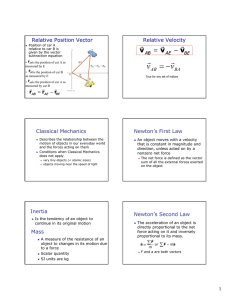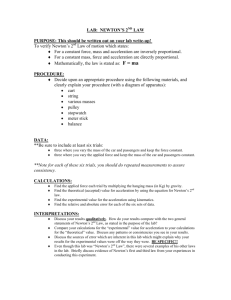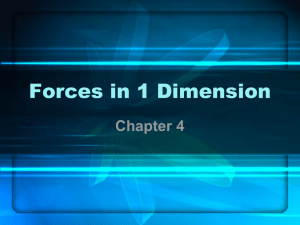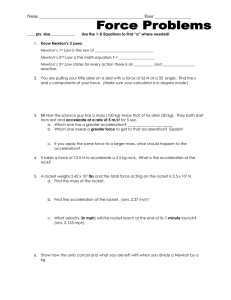Forces Book Assignment Name ___________________________________________________ Hour ___________
advertisement
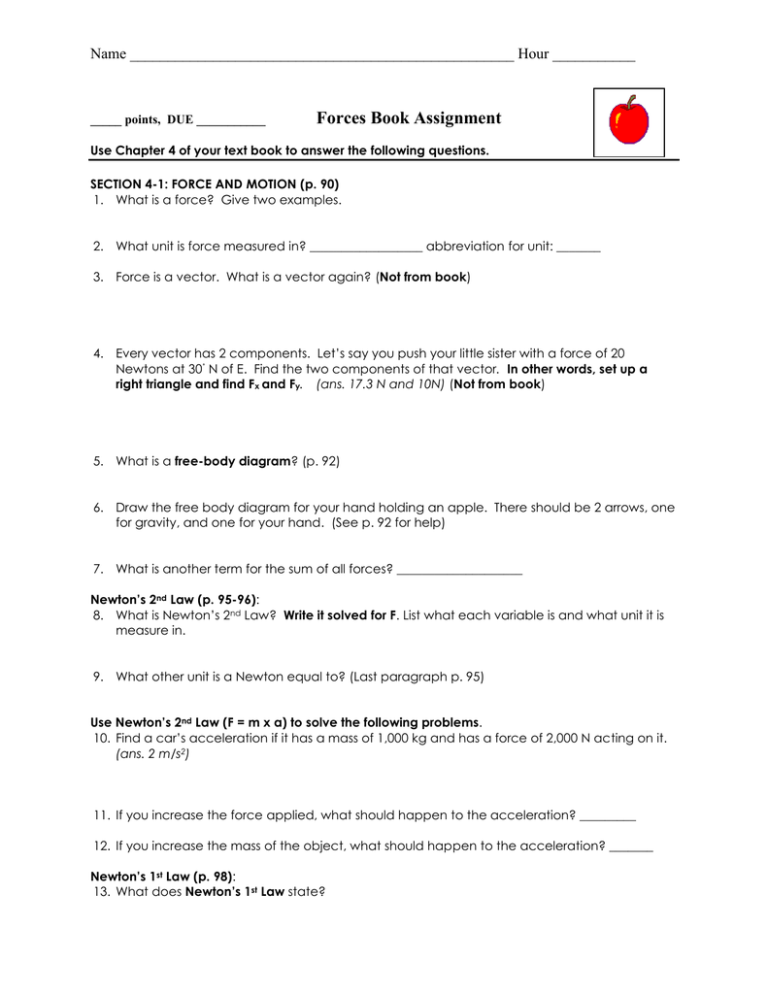
Name ___________________________________________________ Hour ___________ _____ points, DUE ___________ Forces Book Assignment Use Chapter 4 of your text book to answer the following questions. SECTION 4-1: FORCE AND MOTION (p. 90) 1. What is a force? Give two examples. 2. What unit is force measured in? __________________ abbreviation for unit: _______ 3. Force is a vector. What is a vector again? (Not from book) 4. Every vector has 2 components. Let’s say you push your little sister with a force of 20 Newtons at 30˚ N of E. Find the two components of that vector. In other words, set up a right triangle and find Fx and Fy. (ans. 17.3 N and 10N) (Not from book) 5. What is a free-body diagram? (p. 92) 6. Draw the free body diagram for your hand holding an apple. There should be 2 arrows, one for gravity, and one for your hand. (See p. 92 for help) 7. What is another term for the sum of all forces? ____________________ Newton’s 2nd Law (p. 95-96): 8. What is Newton’s 2nd Law? Write it solved for F. List what each variable is and what unit it is measure in. 9. What other unit is a Newton equal to? (Last paragraph p. 95) Use Newton’s 2nd Law (F = m x a) to solve the following problems. 10. Find a car’s acceleration if it has a mass of 1,000 kg and has a force of 2,000 N acting on it. (ans. 2 m/s2) 11. If you increase the force applied, what should happen to the acceleration? _________ 12. If you increase the mass of the object, what should happen to the acceleration? _______ Newton’s 1st Law (p. 98): 13. What does Newton’s 1st Law state? Name ___________________________________________________ Hour ___________ 14. Newton’s 1st law is also known as the law of ____________________________ 15. Define inertia. 16. What is equilibrium? 17. What are the 2 times an object can be in equilibrium? (See picture at top of page) Weight and Drag Force (p. 100): 18. Define weight: 19. What unit is weight measured in? ___________ 20. What is the equation we use to find weight? ________________ 21. Calculate the force you exert on the earth, (your weight in N) if you have a mass of 60 kg. (The acceleration here is the acceleration due to gravity. The earth pulls down giving you weight) (ans. -588 N) 22. What is the difference between mass and weight? Would your weight change on the moon? Mass? (Not stated in book: Apply what you know about weight and mass) 23. What is drag force? 24. Drag force would be an example of _________________ -which is the force that opposes motion. 25. What is terminal velocity? 26. Should lighter or heavier objects reach terminal velocity faster? Why? Newton’s 3rd Law (p. 106): 27. What is an interaction pair? What is another name for it? 28. What is Newton’s 3rd Law? Use the last paragraph on p. 106. 29. You hit the head of a nail with a hammer. (Not in book) a. Does the nail or hammer experience greater force or is it the same? Explain. b. Which would experience the greater acceleration? Explain.
